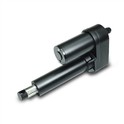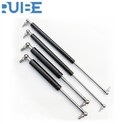When it comes to tool boxes, gas struts play a crucial role in ensuring smooth and efficient operation. As a supplier of Gas Struts For Tool Box, I often receive inquiries about the appropriate extension length of gas struts for tool boxes. In this blog post, I will delve into the factors that determine the extension length of gas struts for tool boxes and provide some guidelines to help you make the right choice.
Understanding Gas Struts
Before we discuss the extension length, let's first understand what gas struts are. Gas struts, also known as gas springs or gas shocks, are mechanical devices that use compressed gas to provide a controlled force. They consist of a cylinder filled with nitrogen gas and a piston rod that moves in and out of the cylinder. When the piston rod is compressed, the gas inside the cylinder is compressed, creating a force that pushes the piston rod back out. This force can be used to support the weight of a tool box lid or to assist in opening and closing the lid.
Factors Affecting the Extension Length
The extension length of a gas strut for a tool box depends on several factors, including the size and weight of the tool box, the type of lid, and the desired opening angle. Let's take a closer look at each of these factors:


Size and Weight of the Tool Box
The size and weight of the tool box are the most important factors to consider when determining the extension length of the gas strut. A larger and heavier tool box will require a gas strut with a longer extension length and a higher force rating to support the weight of the lid. On the other hand, a smaller and lighter tool box will require a gas strut with a shorter extension length and a lower force rating.
Type of Lid
The type of lid on the tool box also affects the extension length of the gas strut. There are two main types of lids: hinged lids and sliding lids. Hinged lids are the most common type of lid and require a gas strut to support the weight of the lid and assist in opening and closing. Sliding lids, on the other hand, do not require a gas strut to support the weight of the lid but may require a gas strut to assist in opening and closing.
Desired Opening Angle
The desired opening angle of the tool box lid is another important factor to consider when determining the extension length of the gas strut. The opening angle refers to the angle at which the lid opens relative to the tool box. A larger opening angle will require a gas strut with a longer extension length to ensure that the lid can open fully.
Calculating the Extension Length
Once you have considered the factors above, you can calculate the extension length of the gas strut for your tool box. The following formula can be used to calculate the extension length:
Extension Length = (Lid Length x Sin(Opening Angle)) + (Lid Thickness / 2)
Where:
- Lid Length is the length of the tool box lid.
- Opening Angle is the desired opening angle of the tool box lid.
- Lid Thickness is the thickness of the tool box lid.
Let's take an example to illustrate how to use this formula. Suppose you have a tool box with a lid length of 24 inches, a lid thickness of 1 inch, and a desired opening angle of 90 degrees. Using the formula above, we can calculate the extension length as follows:
Extension Length = (24 x Sin(90)) + (1 / 2)
Extension Length = (24 x 1) + 0.5
Extension Length = 24.5 inches
Therefore, you will need a gas strut with an extension length of 24.5 inches to support the weight of the lid and ensure that it can open fully.
Choosing the Right Gas Strut
Once you have calculated the extension length of the gas strut for your tool box, you can choose the right gas strut based on the force rating and the mounting options. The force rating of the gas strut refers to the amount of force that the gas strut can provide. It is important to choose a gas strut with a force rating that is appropriate for the weight of the tool box lid. The mounting options refer to the way in which the gas strut is attached to the tool box and the lid. There are several different mounting options available, including ball joints, eyelets, and brackets.
As a supplier of Gas Struts For Tool Box, we offer a wide range of gas struts with different extension lengths, force ratings, and mounting options to meet the needs of our customers. Our gas struts are made from high-quality materials and are designed to provide reliable and long-lasting performance.
Other Applications of Gas Struts
In addition to tool boxes, gas struts are also used in a variety of other applications, including Gas Spring for Wall Bed and Gas Spring for Storage Bed. Wall beds and storage beds require gas struts to support the weight of the bed and assist in opening and closing. Gas struts are also used in automotive applications, such as hoods, trunks, and tailgates, to provide a controlled force for opening and closing.
Conclusion
In conclusion, the extension length of the gas strut for a tool box depends on several factors, including the size and weight of the tool box, the type of lid, and the desired opening angle. By considering these factors and using the formula provided, you can calculate the extension length of the gas strut for your tool box and choose the right gas strut based on the force rating and the mounting options. As a supplier of Gas Struts For Tool Box, we are committed to providing our customers with high-quality gas struts that meet their needs. If you have any questions or need assistance in choosing the right gas strut for your tool box, please do not hesitate to contact us. We look forward to working with you to find the perfect gas strut solution for your application.
References
- "Gas Springs: Design and Application." Pneumatic Automation Handbook, edited by Peter Nachtwey, Elsevier, 2015.
- "Gas Strut Selection Guide." Suspa Inc., 2021.






